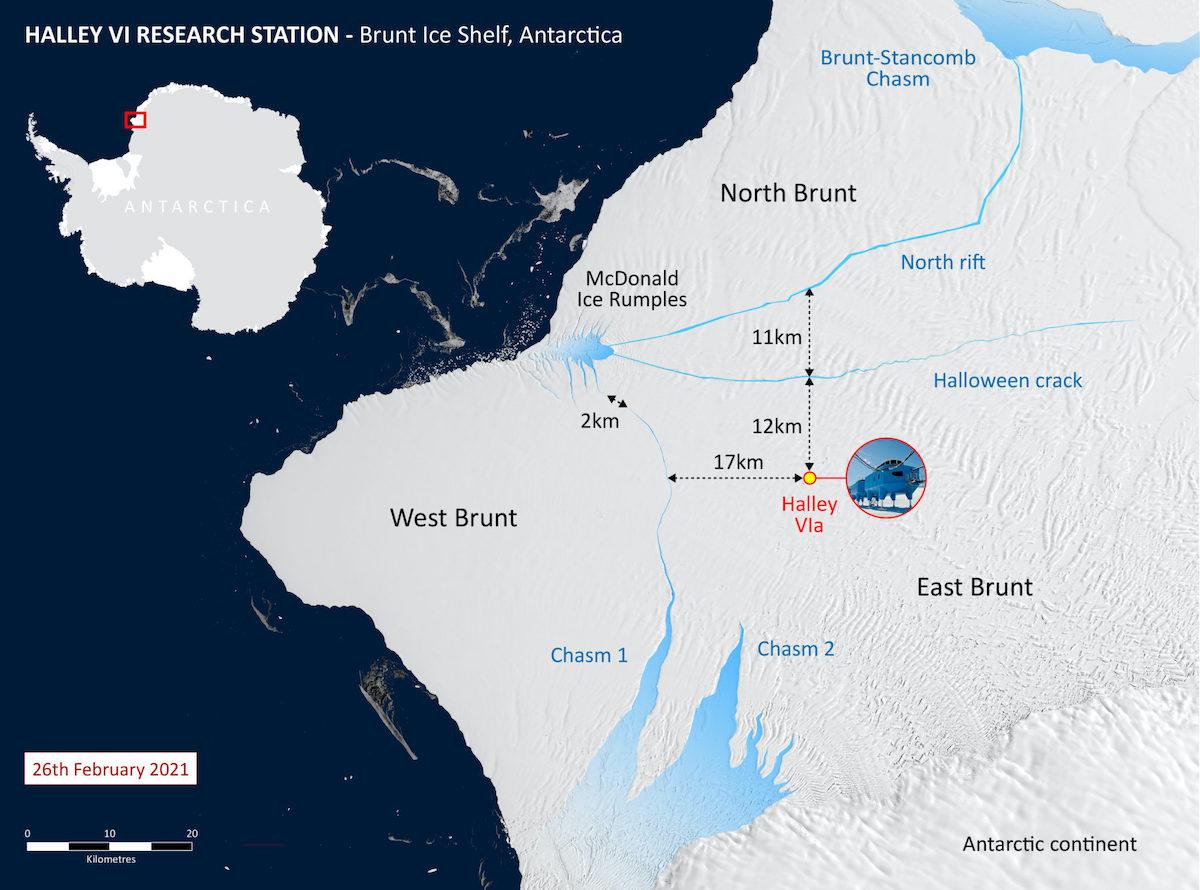Antarctic Ice Shelf Loses 490-Square-Mile Iceberg — a Decade in the Making
The Brunt Ice Shelf in Antarctica just lost a massive iceberg.
Updated March 4 2021, 12:22 p.m. ET

The Brunt Ice Shelf in Antarctica calves.
An enormous crack in the Brunt Ice Shelf in Antarctica just lost a massive iceberg. The event has been a decade in the making.
British Antarctic Survey’s (BAS) scientists have been observing this particular iceberg on the Brunt Ice Shelf since nearly 10 years ago, when they first observed cracks growing in the ice. The team has spent the last decade waiting for something like this to happen, and on the morning of Feb. 26, 2021, a giant crack on the ice shelf that had been widening since November 2020 finally calved, setting off a colossal iceberg.
The iceberg that broke off Antarctica’s Brunt Ice Shelf was huge.

Map of Brunt ice shelf and Halley Research Station
The iceberg that broke off the Brunt Ice Shelf was 1,270 square kilometers (about 490 square miles) in area — that’s about the area of the city of Phoenix, or around 22 Manhattans. The shelf was about 150 meters (492 feet) tall — that’s the height of the Washington Monument. That’s far bigger than the iceberg that sank the Titanic — that infamous iceberg was estimated to be about 400 feet long, according to NDTV.
It’s almost impossible to imagine a floating sheet of ice quite so large, but one now exists, and it’s floating around in Antarctic waters.
Again, the BAS team has been prepared for this event for years — in fact, around four years ago, they moved the Halley Research Station to a new Antarctic location in preparation for the formation of this iceberg. (Staff only work out of the station during the Antarctic summer, because in the winter, it gets too dark for people to evacuate safely in case of emergency.)
“This is a dynamic situation. Four years ago we moved Halley Research Station inland to ensure that it would not be carried away when an iceberg eventually formed,” BAS Director of Operations Simon Garrod said in a statement.
“That was a wise decision. Our job now is to keep a close eye on the situation and assess any potential impact of the present calving on the remaining ice shelf,” Garrod continued. “We continuously review our contingency plans to ensure the safety of our staff, protect our research station, and maintain the delivery of the science we undertake at Halley.”
For years, the BAS team has been monitoring the ice shelf’s movements 24/7 using GPS instruments and satellite images. Now that the iceberg has finally split off from the Brunt Ice Shelf, the BAS researchers will continue to monitor it.
“Over coming weeks or months, the iceberg may move away; or it could run aground and remain close to Brunt Ice Shelf,” Professor Dame Jane Francis, Director of BAS, said in a statement. “Halley Station is located inland of all the active chasms, on the part of the ice shelf that remains connected to the continent. Our network of GPS instruments will give us early warning if the calving of this iceberg causes changes in the ice around our station.”
How are icebergs formed? Climate change has to do with it.
As humans continue to burn fossil fuels and carry out other activities that put greenhouse gases into the atmosphere, the planet continues to warm. As explained by The Seattle Post-Intelligencer, these rising temperatures cause ice sheets to melt, and subsequently, icebergs to calve from ice caps.
However, BAS scientists stated that this calving event was natural, and there is "no evidence that climate change has played a significant role."